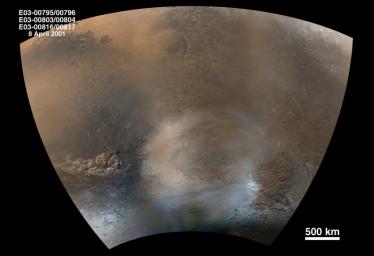
|
Mid-Winter Dust Storms Near Hellas Planitia
- Click the image above for a larger view
- Full-Res JPEG (1460 x 1000) (106.9 kB)
- Full-Res TIFF (1460 x 1000) (2.5 MB)
Caption:
One of the primary objectives for the Mars Global Surveyor (MGS) Mars Orbiter Camera (MOC) during the Extended Mission is to continue daily monitoring of martian weather as expressed in clouds, dust storms, and patches of polar frost. During the Primary Mission, which lasted from March 1999 through January 2001, changes that occurred over a single martian year (687 Earth days) were observed. Now it is possible to see what the martian atmosphere will do for at least two-thirds of a second martian year, because the Extended Mission will run into April 2002.
This picture captures two dust storms, each large enough to cover Arizona or New Mexico. One is located near the lower left, the other at the lower right. Taken on April 8, 2001 (mid-southern winter), this is a mosaic of six MOC daily global images centered around Hellas Planitia in the martian southern hemisphere. Hellas Planitia is the dominant elliptical feature just below the center of the picture. The bright, nearly white surfaces along the lower (southern) edge of the picture are covered by wintertime frost. The strong temperature difference between the winter frost and the warmer air just off the edge of this polar cap generates winds that--at this time of year--are often strong enough to lift dust into large, reddish-brown, billowy clouds.
North is up and sunlight illuminates the area from the upper left. The martian equator forms the arc along the top of the picture; 500 kilometers (km) is equal to about 311 miles. The approximately 500 kilometer-wide circular feature just above the center is the crater Huygens.
Cataloging Keywords:
| Name | Value | Additional Values |
|---|---|---|
| Target | Mars | |
| System | ||
| Target Type | Planet | |
| Mission | Mars Global Surveyor (MGS) | |
| Instrument Host | Mars Global Surveyor | |
| Host Type | Orbiter | |
| Instrument | Mars Orbiter Camera (MOC) | |
| Detector | ||
| Extra Keywords | Atmosphere, Color, Crater, Dust, Storm | |
| Acquisition Date | ||
| Release Date | 2001-05-24 | |
| Date in Caption | 2001-04-08 | |
| Image Credit | NASA/JPL/MSSS | |
| Source | photojournal.jpl.nasa.gov/catalog/PIA03222 | |
| Identifier | PIA03222 | |
